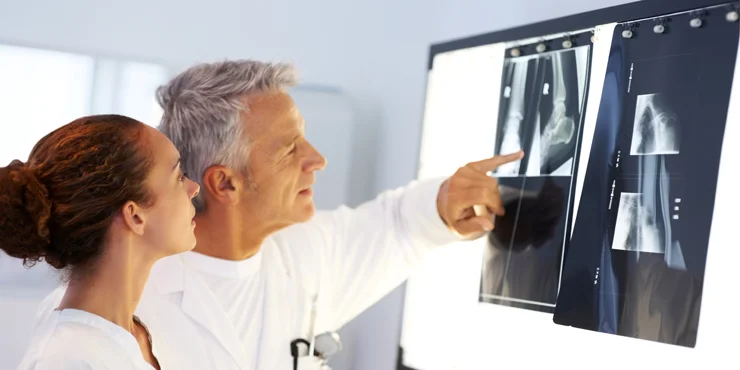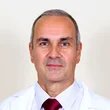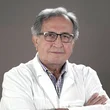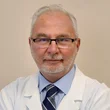This is how our application simplifies the booking and administration process. Interested >>
Orthopedics
Orthopedics is a branch of medical science that deals with congenital and acquired abnormalities of the musculoskeletal system. The coordinated movements of bones, joints, muscles and other soft tissues form a complex system. The available conservative and surgical procedures provide solutions for acute and chronic disorders which affect this system.

Our orthopedic clinic provides complete investigation, diagnostics and treatment of musculoskeletal diseases including physiotherapy, physical therapy, conservative treatment, and orthopedic surgeries too. All of these contribute to the improvement of the quality of life and the reduction of the musculoskeletal symptoms.
Which symptoms indicate that I should see an orthopedic specialist?
An orthopedic examination may be beneficial in case of symptoms which are mainly accompanied by chronic pain, joint swelling and/or movement disability, such as:
- spinal symptoms (low back pain, thoracic pain, neck pain),
- herniated disc,
- hip problems (pain during loading, wear and tear of the hip joint),
- knee problems (wear and tear of the knee joint, knee ligament injuries, meniscus injuries, changes in the joint axis, patella dislocation, frontal knee pain, symptoms indicating instability),
- shoulder problems (pain, movement disability, rotator cuff problems, impingement, frozen shoulder syndrome),
- diseases of the limb bones and joints,
- overload symptoms (tennis elbow, golfer’s elbow, bursitis, tunnel syndromes, jumper’s knee syndrome, Achilles’ tendonitis),
- joint inflammation, degenerative joint diseases,
- ankle injuries, instability, ankle joint wear and tear,
- foot deformities (bunions, hammer toe, hallux rigidus),
- hand problems which may require surgery (carpal tunnel syndrome, Dupuytren’s contracture, trigger finger, wear and tear of the saddle joint),
- other sport injuries, muscle ruptures, muscle strains.
What happens during an orthopedic examination?
Medical history is taken with special attention to the musculoskeletal system, which includes the patient’s previous musculoskeletal diseases, surgeries, accidents (fractures, strains, dislocations) and information about the patient’s lifestyle (sport activities, work environment).
- Gait examination and postural examination,
- morphological and functional examination of the chest and the spine,
- sensory examination of the upper and the lower limbs,
- motor examination of the upper and the lower limbs,
- deep reflexes, pathological reflexes,
- morphological and functional examination of the joints; deformities,
- examining the major joints’ range of movement (shoulders, hips, knees, ankles),
- examining the stability of small and large joints,
- examining the limb axes,
- foot deformities,
- additional targeted examinations in case of symptoms or diseases which are included in the medical history,
- X-ray scan, ultrasound scan, MRI scan and CT scan of the bones and/or joints, whichever is necessary for making the diagnosis.
What treatment options are available?
The orthopedic specialist determines the necessary treatment option. The goal is to abolish the musculoskeletal pain as soon as possible and that the patient’s movement capacity is restored.
- Conservative treatments include physiotherapy, physical therapy treatments, therapeutic massage.
- Medicinal treatment (painkillers, anti-inflammatory drugs, injections with hyaluronic acid),
- PRP treatment when the patient’s own blood is used for therapy,
- epidural infiltration, nerve root block (lower back),
- spine surgeries,
- prosthetic surgeries of the hips, knees, and ankles,
- robot-assisted knee replacement surgery,
- open and arthroscopic knee surgeries, cruciate ligament surgeries,
- open and arthroscopic shoulder surgeries,
- open and arthroscopic elbow surgeries,
- revisional prosthetic surgeries,
- osteotomies,
- open and arthroscopic ankle joint surgeries,
- hand surgeries,
- simple and complex foot surgeries,
- Achilles’ tendon surgery.
Which are the most common orthopedic problems?
- herniated disc
- cartilage wear and tear
- tendonitis, tenosynovitis
- scoliosis
- disrupted cartilage of the knee joint, cartilage wear and tear
- knee ligament injuries
- tennis elbow, golfer’s elbow
- shoulder impingement syndrome, rotator cuff injuries
- nerve compression syndromes
- flat feet
- bunions, hammer toe
- ganglion, bursitis
The description of the orthopedic clinic was made by the contribution of Dr. Péter Hidas PhD, orthopedic specialist, chief physician.
If the patient shows symptoms suggestive of COVID infection, a rapid antigen test may be requested at the discretion of the physician.
Feel free to contact our specialists!
At the Buda Health Center, you have the opportunity to attend the private practices of more than 300 renowned specialists, offering expertise in nearly 45 medical specialisms, at five locations. Personalized care is provided by a well-trained and empathetic staff of professionals, who have been working together for a long time. Based on our 24 years of experience and the feedback received from our 450,000 clients, we are constantly working to organize our healthcare services in the most efficient way possible for those who visit us, paying respect to their needs and time.












